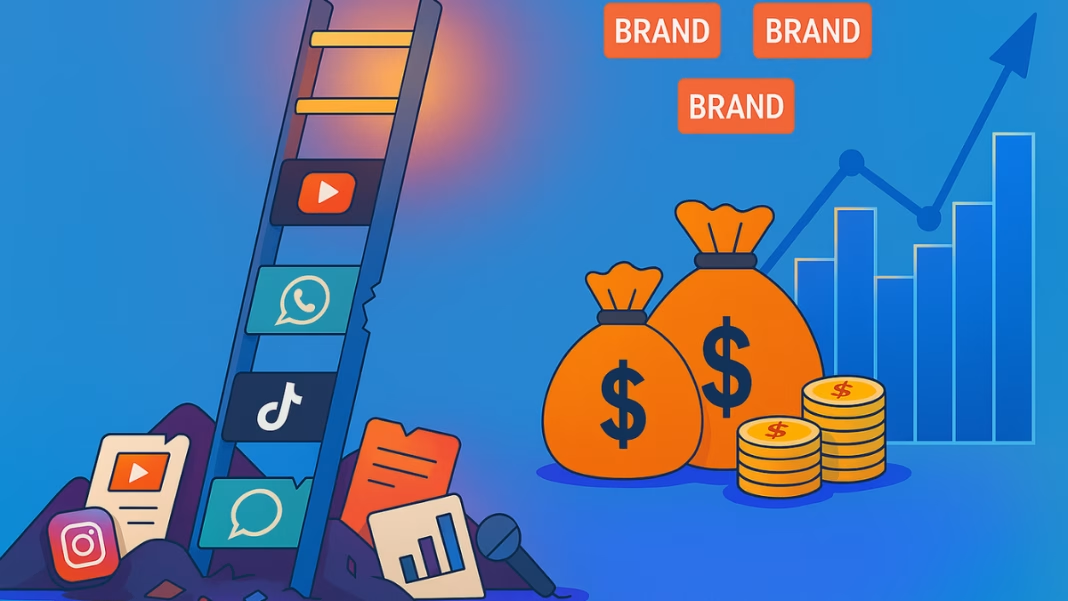The creator economy in India looks exciting. Millions of young people dream of being content creators, influencers, or digital storytellers. They see viral videos, glamorous shoots, and creators earning big money.
A Dream Career That’s Not So Easy
On the surface, it feels like a dream job. But behind the scenes, things are very different.
India now has more than 8 million content creators across different platforms. This includes people who post videos, write blogs, share art, or teach skills online. But for most, it’s hard to earn enough money to live on. Many creators have left the field since 2024. Not because they lacked talent—but because they could not survive the unstable income and low payouts.
According to estimates, brands spend around ₹3,500 crores on digital content. But a small group—only about 1–2% of creators—earn most of that money. Nearly 90% of creators are part-timers or struggle to make a stable living. Only 5–10% of creators earn ₹50,000 or more per month.
To compare, about 97.6% of gig workers in India earn less than ₹5 lakh a year. Around 77.6% earn only ₹2.5 lakh or less. So while creators may earn more than some gig workers, the numbers are still not enough to support full-time careers for most.
A major issue is low ad revenue. For example, YouTube pays between ₹30–₹250 per 1,000 views. Indian creators often earn much less than those in other countries. Smaller creators also struggle to find sponsors, since brands usually focus on bigger names. In fact, only 8–10% of creators are able to earn money from their content.
Another hidden issue is that many new creators quit within a year. This is called “creator churn.” These creators enter the field with passion, but the pressure to constantly create, poor earnings, and lack of proper support make it hard to continue. Many burn out or simply give up.
Money, Algorithms, and Unfair Systems
Another big problem is how brands pay creators. Most companies follow what experts call a “barbell strategy.” This means they pay a lot to very famous creators and give small amounts to nano-influencers. Mid-level influencers are stuck in the middle. They are not as cheap as small influencers and not as famous as big stars. So, they often get ignored in campaigns.
For brands, this strategy makes business sense. Big names help them get more attention quickly. Small influencers give high engagement for less money. But mid-tier influencers get left out, even if their content is high-quality.
🌐 Teen Hacker’s $37M Crypto Crime Spree Exposed: Inside the SIM Swap That Shook the Blockchain
Creators also depend heavily on social media platforms. Their income depends on how the platform’s algorithm works. But these algorithms are not public. If the algorithm changes, it can suddenly cut a creator’s reach and income. Even top creators can lose earnings overnight without warning.
Monetization is also very limited. Each platform has its own rules, and not all creators qualify. Ad revenue, sponsorships, or fan support like tips and memberships are not available to everyone. Many creators depend on just one platform, making their income even riskier.
Another issue is income instability. Even with a large fan base, earnings can swing up and down. One month a creator may earn ₹20,000. Next month, they may earn nothing. With no fixed income or contracts, many cannot manage daily expenses or plan for the future.
No Recognition, No Support
Despite playing a key role in digital marketing, creators in India have no formal recognition. They are not seen as part of any industry. They do not get labor rights, contracts, or timely payments.
According to BCG, creators now influence more than $350 billion in consumer spending every year. This number is expected to grow quickly. But creators are still working without any structure, rules, or protections.
In 2024, the Indian government announced a $1 billion fund to support the creator economy. This fund aims to help creator with money and training. It also supports the creation of an Indian Institute of Creative Technology, with ₹391 crore allocated to train people in digital skills.
But experts believe this is just a start. In California, a new law called the Freelance Worker Protection Act was passed. It says any freelance work over $250 must have a written contract. It also requires payments to be made on time. If companies delay payments, they must pay double. India does not yet have similar rules for digital creators.
Most creators also don’t have access to basic financial or legal services. They often handle taxes, contracts, and brand deals alone without expert help. This leads to confusion about payments, legal rights, or intellectual property.
Another growing concern is the rise of AI-generated content and content farms. These large operations use tools to churn out high volumes of generic content. This pushes individual influencers further down in search results, making it harder to grow or even get discovered.
The digital creator economy may be growing fast, but without fair pay and proper support, only a few creators will succeed. Many others may quietly quit, even before they get a chance to shine.





